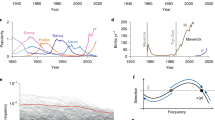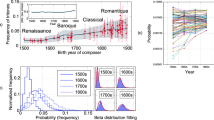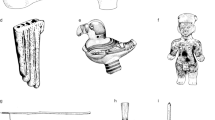Abstract
Here we investigate the evolutionary dynamics of several kinds of modern cultural artefacts—pop music, novels, the clinical literature and cars—as well as a collection of organic populations. In contrast to the general belief that modern culture evolves very quickly, we show that rates of modern cultural evolution are comparable to those of many animal populations. Using time-series methods, we show that much of modern culture is shaped by either stabilizing or directional forces or both and that these forces partly regulate the rates at which different traits evolve. We suggest that these forces are probably cultural selection and that the evolution of many artefact traits can be explained by a shifting-optimum model of cultural selection that, in turn, rests on known psychological biases in aesthetic appreciation. In sum, our results demonstrate the deep unity of the processes and patterns of cultural and organic evolution.
This is a preview of subscription content, access via your institution
Access options
Access Nature and 54 other Nature Portfolio journals
Get Nature+, our best-value online-access subscription
$29.99 / 30 days
cancel any time
Subscribe to this journal
Receive 12 digital issues and online access to articles
$119.00 per year
only $9.92 per issue
Buy this article
- Purchase on Springer Link
- Instant access to full article PDF
Prices may be subject to local taxes which are calculated during checkout





Similar content being viewed by others
Data availability
The data used in the study are available from https://github.com/Armand1/Pace-of-Modern-Culture.
References
Cronk, L. Intelligent design in cultural evolution. Behav. Brain Sci. 29, 352–353 (2006).
Richerson, P. J., Boyd, R. & Henrich, J. Gene–culture coevolution in the age of genomics. Proc. Natl Acad. Sci. USA 107, 8985–8992 (2010).
Mesoudi, A. Cultural Evolution: How Darwinian Theory Can Explain Human Culture and Synthesize the Social Sciences (Univ. Chicago Press, 2011).
Perreault, C. The pace of cultural evolution. PLoS One 7, e45150 (2012).
Haldane, J. B. S. Suggestions as to quantitative measurement of rates of evolution. Evolution 3, 51–56 (1949).
Gingerich, P. D. Rates of evolution—effects of time and temporal scaling. Science 222, 159–161 (1983).
Gingerich, P. D. Quantification and comparison of evolutionary rates. Am. J. Sci. 293A, 453–478 (1993).
Hendry, A. P. & Kinnison, M. T. The pace of modern life: measuring rates of contemporary microevolution. Evolution 53, 1637–1653 (1999).
Kinnison, M. T. & Hendry, A. P. The pace of modern life II: from rates of contemporary microevolution to pattern and process. Genetica 112, 145–164 (2001).
Kuhn, T. The Structure of Scientific Revolutions (Univ. Chicago Press, 1972).
Rosen, C. & Zerner, H. Romanticism and Realism (Faber and Faber, 1984).
Shapin, S. The Scientific Revolution (Univ. Chicago Press, 1996).
Danto, A. C. After the End of Art: Contemporary Art and the Pale of History (Princeton University Press, 1997).
Blanning, T. The Romantic Revolution (Weidenfeld & Nicholson, 2010).
Wooton, D. The Invention of Science: a New History of the Scientific Revolution (Allen Lane, 2015).
Heumakers, A. De Esthetische Revolutie (Boom, 2015).
Mokyr, J. The Lever of Riches: Technological Creativity and Economic Progress (Oxford Univ. Press, 1992).
Basalla, G. The Evolution of Technology (Cambridge Univ. Press, 1988).
Ziman, J. (ed.) Technological Innovation as an Evolutionary Process (Cambridge Univ. Press, 2000).
Steadman, P. The Evolution of Designs: Biological Analogy in Architecture and the Applied Arts (Cambridge Univ. Press, 2008).
Arthur, W. The Nature of Technology: What It Is and How It Evolves (Allen Lane, 2009).
Michel, J. B. et al. Quantitative analysis of culture using millions of digitized books. Science 331, 176–182 (2011).
Serrà, J., Corral, A., Boguñá, M., Haro, M. & Arcos, J. L. I. Measuring the evolution of contemporary western popular music. Sci. Rep. 2, 521 (2012).
Hughes, J. M., Foti, N. J., Krakauer, D. C. & Rockmore, D. N. Quantitative patterns of stylistic influence in the evolution of literature. Proc. Natl Acad. Sci. USA 109, 7682–7686 (2012).
Rodriguez Zivic, P. H., Shifres, F. & Cecchic, G. A. Perceptual basis of evolving western musical styles. Proc. Natl Acad. Sci. USA 110, 10034–10038 (2013).
Mauch, M., MacCallum, R. M., Levy, M. & Leroi, A. M. The evolution of popular music: USA 1960–2010. R. Soc. Open Sci. 2, 150081 (2015).
Estes, S. & Arnold, S. J. Resolving the paradox of stasis: models with stabilizing selection explain evolutionary divergence on all timescales. Am. Nat. 169, 227–244 (2007).
Hunt, G. Evolution in fossil lineages: paleontology and the origin of species. Am. Nat. 176, S61–S76 (2010).
Hunt, G. Measuring rates of phenotypic evolution and the inseparability of tempo and mode. Paleobiology 38, 351–373 (2012).
Hunt, G., Hopkins, M. J. & Lidgard, S. Simple versus complex models of trait evolution and stasis as a response to environmental change. Proc. Natl Acad. Sci. USA 112, 4885–4890 (2015).
Uyeda, J. C., Hansen, T. F., Arnold, S. J. & Pienaar, J. The million-year wait for macroevolutionary bursts. Proc. Natl Acad. Sci. USA 108, 15908–15913 (2011).
Arnold, S. J. Phenotypic evolution: the ongoing synthesis. Am. Nat. 183, 729–746 (2014).
Dobzhansky, T. Mendelian populations and their evolution. Am. Nat. 84, 401–418 (1950).
Hey, J. Regarding the confusion between the population concept and Mayr’s population thinking. Q. Rev. Biol. 86, 253–264 (2011).
Cavalli-Sforza, L. L. & Feldman, M. W. Cultural Transmission and Evolution: a Quantitative Approach. (Princeton Univ. Press, 1981).
Boyd, R. & Richerson, P. J. Culture and the Evolutionary Process (Univ. Chicago Press, 1985).
Mesoudi, A., Whiten, A. & Laland, K. N. Is human cultural evolution Darwinian? Evidence reviewed from the perspective of the origin of species. Evolution 58, 1–11 (2004).
O’Brien, M. J. & Lyman, R. L. Applying Evolutionary Archaeology: a Systematic Approach (Springer, 2000).
Mesoudi, A. & O’Brien, M. J. The cultural transmission of Great Basin projectile-point technology I: an experimental simulation. Am. Antiq. 73, 3–28 (2008).
Benjamin, W. Illuminations: Essays and Reflections (Schocken, 1969).
Jockers, M. Macroanalysis: Digital Methods and Literary History (Univ. Illinois Press, 2013).
Blei, D. M., Ng, A. Y. & Jordan, M. I. Latent Dirichlet allocation. J. Mach. Learn. Res. 3, 993–1022 (2003).
O’Brien, M. J., Lyman, R. L., Mesoudi, A. & VanPool, T. L. Cultural traits as units of analysis. Philos. Trans. R. Soc. B 365, 3797–3806 (2010).
Jones, D. A. 50 years of studying the scarlet tiger moth. Trends Ecol. Evol. 4, 298–301 (1989).
Cook, L. M. The rise and fall of the carbonaria form of the peppered moth. Q. Rev. Biol. 78, 399–417 (2003).
Grant, P. R. & Grant, B. R. Unpredictable evolution in a 30-year study of Darwin’s finches. Science 296, 707–711 (2002).
Cain, A. J., Cook, L. M. & Currey, J. D. Population size and morph frequency in a long-term study of Cepaea nemoralis. Proc. R. Soc. B 240, 231–250 (1990).
Kurten, B. Rates of evolution in fossil mammals. Cold Spring Harb. Symp. Quant. Biol. 24, 205–215 (1959).
Sheets, H. & Mitchell, C. Uncorrelated change produces the apparent dependence of evolutionary rate on interval. Paleobiology 27, 429–445 (2001).
Roopnarine, P. Analysis of rates of morphologic evolution. Annu. Rev. Ecol. Evol. Syst. 34, 605–632 (2003).
Gingerich, P. D. Rates of evolution. Annu. Rev. Ecol. Evol. Syst. 40, 657–675 (2009).
Bell, M. A. & Aguirre, W. E. Contemporary evolution, allelic recycling, and adaptive radiation of the threespine stickleback. Evol. Ecol. Res. 15, 377–411 (2013).
Grant, P. R. & Grant, B. R. 40 Years of Evolution: Darwin’s Finches on Daphne Major Island (Princeton Univ. Press, 2014).
Beacham, T. Variability in median size and age at sexual maturity of Atlantic cod, Gadus morhua, on the Scotian shelf in the Northwest Atlantic Ocean. Fish. Bull. 81, 303–321 (1983).
Coltman, D. W. et al. Undesirable evolutionary consequences of trophy hunting. Nature 426, 655–658 (2003).
Pigeon, G., Festa-Bianchet, M., Coltman, D. W. & Pelletier, F. Intense selective hunting leads to artificial evolution in horn size. Evol. Appl. 9, 521–530 (2016).
Seeley, R. Intense natural selection caused a rapid morphological transition in a living marine snail. Proc. Natl Acad. Sci. USA 83, 6897–6901 (1986).
Trussell, G. & Smith, L. Induced defenses in response to an invading crab predator: an explanation of historical and geographic phenotypic change. Proc. Natl Acad. Sci. USA 97, 2123–2127 (2000).
Olsen, E. et al. Maturation trends indicative of rapid evolution preceded the collapse of northern cod. Nature 428, 932–935 (2004).
Carroll, S. et al. And the beak shall inherit—evolution in response to invasion. Ecol. Lett. 8, 944–951 (2005).
Reznick, D. N., Shaw, F. H., Rodd, F. H. & Shaw, R. G. Evaluation of the rate of evolution in natural populations of guppies (Poecilia reticulata). Science 275, 1934–1937 (1997).
Gotanda, K. M., Correa, C., Turcotte, M. M., Rolshausen, G. & Hendry, A. P. Linking macrotrends and microrates: re-evaluating microevolutionary support for Cope’s rule. Evolution 69, 1345–1354 (2015).
Kimura, M. & Ohta, T. The average number of generations until fixation of a mutant gene in a finite population. Genetics 61, 763–771 (1969).
Henrich, J. Demography and cultural evolution: how adaptive cultural processes can produce maladaptive losses: the Tasmanian case. Am. Antiq. 69, 197–214 (2004).
Aoki, K., Lehmann, L. & Feldman, M. W. Rates of cultural change and patterns of cultural accumulation in stochastic models of social transmission. Theor. Popul. Biol. 79, 192–202 (2011).
Nakahashi, W. The effect of cultural interaction on cumulative cultural evolution. J. Theor. Biol. 352, 6–15 (2014).
Hunt, G. Fitting and comparing models of phyletic evolution: random walks and beyond. Paleobiology 32, 578–601 (2006).
Hunt, G. The relative importance of directional change, random walks, and stasis in the evolution of fossil lineages. Proc. Natl Acad. Sci. USA 104, 18404–18408 (2007).
Hunt, G. & Rabosky, D. L. Phenotypic evolution in fossil species: pattern and process. Annu. Rev. Earth Planet. Sci. 42, 421–441 (2014).
Sheets, H. & Mitchell, C. Why the null matters: statistical tests, random walks and evolution. Genetica 112, 105–125 (2001).
Pagel, M., Atkinson, Q. D. & Meade, A. Frequency of word-use predicts rates of lexical evolution throughout Indo-European history. Nature 449, 717 (2007).
Martin, G. in Technological Innovation as an Evolutionary Process (ed. Ziman, J.) Ch. 8 (Cambridge Univ. Press, 2000).
Moore, G. E. Cramming more components onto integrated circuits. Electronics 38, 114–117 (1965).
Shennan, S. & Wilkinson, J. Ceramic style change and neutral evolution: a case study from neolithic europe. Am. Antiq. 66, 577–593 (2001).
Hahn, M. & Bentley, R. Drift as a mechanism for cultural change: an example from baby names. Proc. R. Soc. B 270, S120–S123 (2003).
Bentley, R., Hahn, M. & Shennan, S. Random drift and culture change. Proc. R. Soc. B 271, 1443–1450 (2004).
Bentley, R. A., Lipo, C. P., Herzog, H. A. & Hahn, M. W. Regular rates of popular culture change reflect random copying. Evol. Hum. Behav. 28, 151–158 (2007).
Lycett, S. J. Acheulean variation and selection: does handaxe symmetry fit neutral expectations? J. Archaeol. Sci. 35, 2640–2648 (2008).
Bentley, R. A., Ormerod, P. & Shennan, S. Population-level neutral model already explains linguistic patterns. Proc. R. Soc. B 278, 1770–1772 (2011).
Acerbi, A. & Bentley, R. A. Biases in cultural transmission shape the turnover of popular traits. Evol. Hum. Behav. 35, 228–236 (2014).
Lynch, M. The rate of morphological evolution in mammals from the standpoint of the neutral expectation. Am. Nat. 136, 727–741 (1990).
Hubbell, S. P. The Unified Neutral Theory of Biodiversity and Biogeography (Princeton Univ. Press, 2001).
Rosindell, J., Hubbell, S. P., He, F., Harmon, L. J. & Etienne, R. S. The case for ecological neutral theory. Trends Ecol. Evol. 27, 203–208 (2012).
Fama, E. F. Efficient capital markets: a review of theory and empirical work. Finance 25, 383–417 (1970).
Piotroski, J. D. Value investing: the use of historical financial statement information to separate winners from losers. J. Account. Res. 38, 1–41 (2000).
Poterba, J. M. & Summers, L. H. Mean reversion in stock prices: evidence and implications. J. Financ. Econ. 22, 27–59 (1988).
Lo, A. W. Adaptive markets: Financial Evolution at the Speed of Thought (Princeton, 2017).
Bentley, R. A. Random drift versus selection in academic vocabulary: an evolutionary analysis of published keywords. PLoS One 3, e3057 (2008).
Brantingham, P. J. & Perreault, C. Detecting the effects of selection and stochastic forces in archaeological assemblages. J. Archaeol. Sci. 37, 3211–3225 (2010).
Crema, E. R., Kandler, A. & Shennan, S. Revealing patterns of cultural transmission from frequency data: equilibrium and non-equilibrium assumptions. Sci. Rep. 6, 39122 (2016).
MacCallum, R. M., Mauch, M., Burt, A. & Leroi, A. M. Evolution of music by public choice. Proc. Natl Acad. Sci. USA 109, 12081–12086 (2012).
Sperber, D. Explaining Culture (Blackwell, 1996).
Sperber, D. & Hirschfeld, L. A. The cognitive foundations of cultural stability and diversity. Trends Cogn. Sci. 8, 40–46 (2004).
Claidière, N. & Sperber, D. Imitation explains the propagation, not the stability of animal culture. Proc. R. Soc. B 277, 651–659 (2010).
Claidière, N., Kirby, S. & Sperber, D. Effect of psychological bias separates cultural from biological evolution. Proc. Natl Acad. Sci. USA 109, E3526–E3526 (2012).
Leroi, A. M., MacCallum, R. M., Mauch, M. & Burt, A. Reply to Claidière et al.: Role of psychological bias in evolution depends on the kind of culture. Proc. Natl Acad. Sci. USA 109, E3527–E3527 (2012).
Cladière, N., Scott-Phillips, T. & Sperber, D. How Darwinian is cultural evolution? Philos. Trans. R. Soc. B 369, 1471–297 (2014).
Gould, S. J. The Structure of Evolutionary Theory (Harvard Univ. Press, Cambridge, MA, 2002).
Charlesworth, B., Lande, R. & Slatkin, M. A neo-Darwinian commentary on macroevolution. Evolution 36, 474–498 (1982).
Charlesworth, B. & Lande, R. Morphological stasis and developmental constraint—no problem for neo-Darwinism. Nature 296, 610 (1982).
Bond, A. B. The evolution of color polymorphism: crypticity searching images, and apostatic selection. Annu. Rev. Ecol. Evol. Syst. 38, 489–514 (2007).
Cook, L. M. Selection and disequilibrium in Cepaea nemoralis. Biol. J. Linn. Soc. 108, 484–493 (2013).
Stanley, S. & Yang, X. Approximate evolutionary stasis for bivalve morphology over millions of years—a multivariate, multilineage study. Paleobiology 13, 113–139 (1987).
Bell, G. Fluctuating selection: the perpetual renewal of adaptation in variable environments. Philos. Trans. R. Soc. B 365, 87–97 (2010).
Bergland, A., Behrman, E., O’Brien, K., Schmidt, P. & Petrov, D. Genomic evidence of rapid and stable adaptive oscillations over seasonal time scales in Drosophila. PLoS Genetics 10, e1004775 (2014).
Hendry, A., Day, T. & Taylor, E. Population mixing and the adaptive divergence of quantitative traits in discrete populations: a theoretical framework for empirical tests. Evolution 55, 459–466 (2001).
Jones, J., Leith, B. & Rawlings, P. Polymorphism in Cepaea: a problem with too many solutions? Annu. Rev. Ecol. Evol. Syst. 8, 109–143 (1977).
Leroi, A. et al. On revolutions. Palgrave Commun. (in the press).
Berlyne, D. Novelty, complexity, and hedonic value. Percept. Psychophys. 8, 279–286 (1970).
Berlyne, D. E. Aesthetics and Psychobiology (Appleton-Century-Crofts, 1971).
Sreenivasan, S. Quantitative analysis of the evolution of novelty in cinema through crowd sourced keywords. Sci. Rep. 3, 2758 (2013).
Simpson, G. G. Tempo and Mode in Evolution (Columbia Univ. Press, 1944).
Lê, S., Josse, J. & Husson, F. FactoMineR: an R package for multivariate analysis. J. Stat. Softw. 25, 1–18 (2008).
Josse, J. & Husson, F. missMDA: a package for handling missing values in multivariate data analysis. J. Stat. Softw. 70, 1–31 (2016).
McCallum, A. K. MALLET: a Machine Learning for Language Toolkit (Univ. Massachussets, 2002).
Carpenter, B. et al. Stan: a probabilistic programming language. J. Stat. Softw. 76, 1–32 (2017).
Gelman, A. & Rubin, D. B. Inference from iterative simulation using multiple sequences. Stat. Sci. 7, 457–472 (1992).
Acknowledgements
We thank A. Burt, G. Bell, L. Cook, D. Coltman, P. Grant, K. Gotanda, M. Fortelius, A. Hendry, M. Johnson, G. Pigeon and M. Pagel for data, advice or comments on the manuscript. The authors received no specific funding for this work.
Author information
Authors and Affiliations
Contributions
B.L. and A.M.L. designed the study, carried out analysis and wrote the paper. G.K., M.M., M.J. and S.A. supplied data and carried out analysis. T.K. supplied data.
Corresponding author
Ethics declarations
Competing interests
The authors declare no competing interests.
Additional information
Primary handling editors: Charlotte Payne and Aisha Bradshaw
Publisher’s note Springer Nature remains neutral with regard to jurisdictional claims in published maps and institutional affiliations.
Supplementary information
Supplementary Information
Supplementary Figs. 1–4, Supplementary Tables 1–7 and Supplementary References.
Rights and permissions
About this article
Cite this article
Lambert, B., Kontonatsios, G., Mauch, M. et al. The pace of modern culture. Nat Hum Behav 4, 352–360 (2020). https://doi.org/10.1038/s41562-019-0802-4
Received:
Accepted:
Published:
Issue Date:
DOI: https://doi.org/10.1038/s41562-019-0802-4
This article is cited by
-
Song lyrics have become simpler and more repetitive over the last five decades
Scientific Reports (2024)
-
Musical preference in an online music community in China
Social Network Analysis and Mining (2022)
-
Climate variations, culture and economic behaviour of Chinese households
Climatic Change (2021)
-
The rhythm of Mexico: an exploratory data analysis of Spotify’s top 50
Journal of Computational Social Science (2021)



